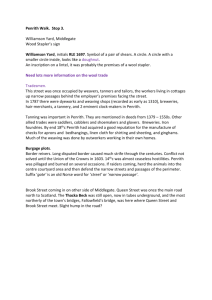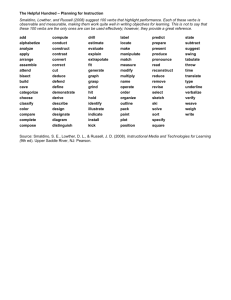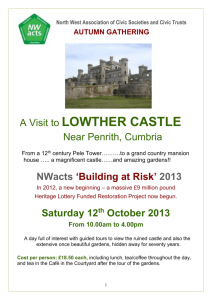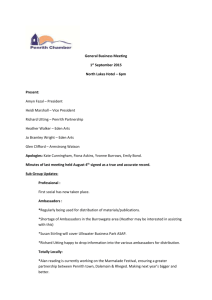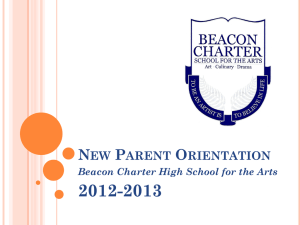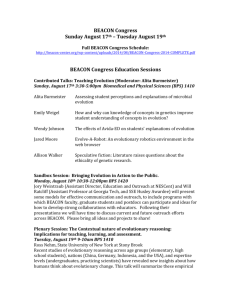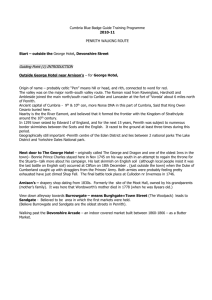Stop 7 Christ Church, RC & Methodist churches RB
advertisement
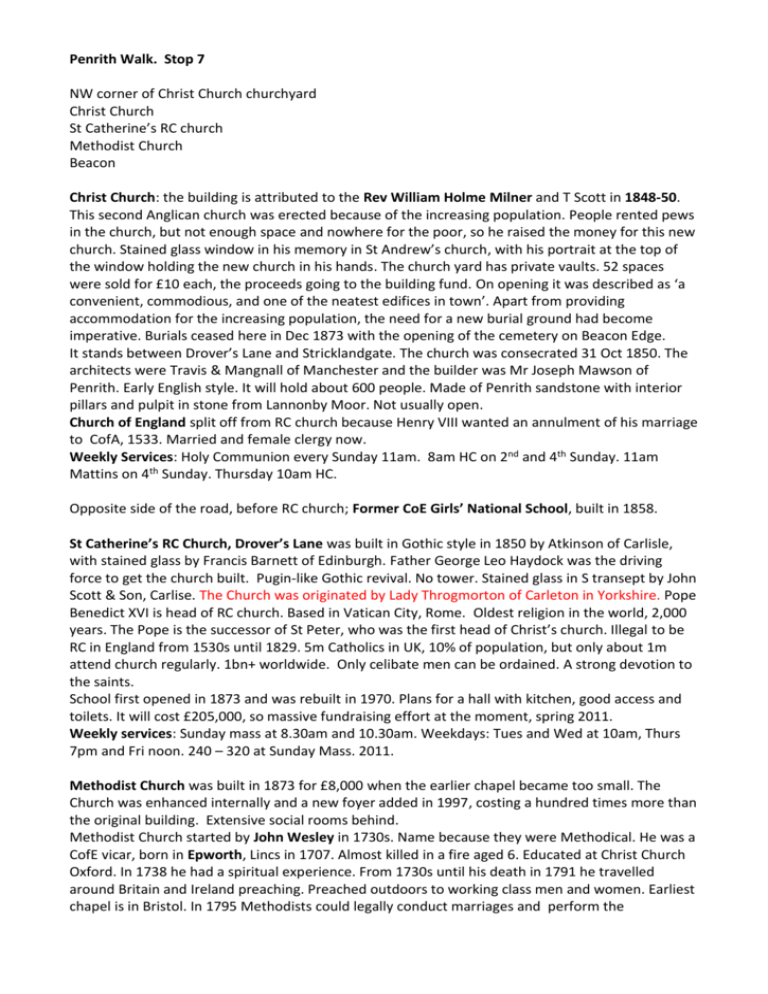
Penrith Walk. Stop 7 NW corner of Christ Church churchyard Christ Church St Catherine’s RC church Methodist Church Beacon Christ Church: the building is attributed to the Rev William Holme Milner and T Scott in 1848-50. This second Anglican church was erected because of the increasing population. People rented pews in the church, but not enough space and nowhere for the poor, so he raised the money for this new church. Stained glass window in his memory in St Andrew’s church, with his portrait at the top of the window holding the new church in his hands. The church yard has private vaults. 52 spaces were sold for £10 each, the proceeds going to the building fund. On opening it was described as ‘a convenient, commodious, and one of the neatest edifices in town’. Apart from providing accommodation for the increasing population, the need for a new burial ground had become imperative. Burials ceased here in Dec 1873 with the opening of the cemetery on Beacon Edge. It stands between Drover’s Lane and Stricklandgate. The church was consecrated 31 Oct 1850. The architects were Travis & Mangnall of Manchester and the builder was Mr Joseph Mawson of Penrith. Early English style. It will hold about 600 people. Made of Penrith sandstone with interior pillars and pulpit in stone from Lannonby Moor. Not usually open. Church of England split off from RC church because Henry VIII wanted an annulment of his marriage to CofA, 1533. Married and female clergy now. Weekly Services: Holy Communion every Sunday 11am. 8am HC on 2nd and 4th Sunday. 11am Mattins on 4th Sunday. Thursday 10am HC. Opposite side of the road, before RC church; Former CoE Girls’ National School, built in 1858. St Catherine’s RC Church, Drover’s Lane was built in Gothic style in 1850 by Atkinson of Carlisle, with stained glass by Francis Barnett of Edinburgh. Father George Leo Haydock was the driving force to get the church built. Pugin-like Gothic revival. No tower. Stained glass in S transept by John Scott & Son, Carlise. The Church was originated by Lady Throgmorton of Carleton in Yorkshire. Pope Benedict XVI is head of RC church. Based in Vatican City, Rome. Oldest religion in the world, 2,000 years. The Pope is the successor of St Peter, who was the first head of Christ’s church. Illegal to be RC in England from 1530s until 1829. 5m Catholics in UK, 10% of population, but only about 1m attend church regularly. 1bn+ worldwide. Only celibate men can be ordained. A strong devotion to the saints. School first opened in 1873 and was rebuilt in 1970. Plans for a hall with kitchen, good access and toilets. It will cost £205,000, so massive fundraising effort at the moment, spring 2011. Weekly services: Sunday mass at 8.30am and 10.30am. Weekdays: Tues and Wed at 10am, Thurs 7pm and Fri noon. 240 – 320 at Sunday Mass. 2011. Methodist Church was built in 1873 for £8,000 when the earlier chapel became too small. The Church was enhanced internally and a new foyer added in 1997, costing a hundred times more than the original building. Extensive social rooms behind. Methodist Church started by John Wesley in 1730s. Name because they were Methodical. He was a CofE vicar, born in Epworth, Lincs in 1707. Almost killed in a fire aged 6. Educated at Christ Church Oxford. In 1738 he had a spiritual experience. From 1730s until his death in 1791 he travelled around Britain and Ireland preaching. Preached outdoors to working class men and women. Earliest chapel is in Bristol. In 1795 Methodists could legally conduct marriages and perform the sacraments. Services tend to emphasise Bible readings and preaching. Hymns. Lay preachers. Early trade unionists. John Wesley is buried at City Road Chapel, London. 4th largest church in UK after Anglican, RC and Church of Scotland. 330,000 members in UK, 75m worldwide. World HQ in N. Carolina. UK HQ is Methodist Central Hall, London. Younger brother Charles was a great hymn writer. Weekly services: Sun 9.00am Early Service. 10.45 Later Service. 4th Sunday 10.45. Sun 6.30 Evening Service. Tues 10am short preaching service. Beacon Pike: 937’/286mt high. Good views from the summit over Eden Valley, Pennines (Cross Fell, 2,930’) and the Lake District. Scotland can be seen on a clear day. Present monument was built in 1719 of sandstone taken from the hill. It replaces an earlier structure and was restored in 1780. The first beacons were piles of wood and branches, replaced by pitch-boxes. There has been a beacon here since 1296, and a building for more than 500 years. It is listed in 1468 communicating with one at Dale Raughton, near Kirkoswald. It links with Carlisle Castle tower and south to Orton Scar. A 1572 survey of Peareth said the beacon or watch-house was in need of repair. It forewarned of numerous Scottish raids over the centuries. Penrith was laid waste in the reigns of Edward III (13271377) and Richard III (1483-1485), finally checked in 1603. The Beacon was lit in 1715 when supporters of the ‘Old Pretender’ arrived in the area. Locals armed with scythes and guns lost their nerve when the saw the rebel forces drawn up in battle order on Penrith Fell. They fled leaving their commanders Viscount Lonsdale and Bishop Nicolson of Carlisle protected only by their servants, so they all fled too! The Beacon again featured during the 1745 uprising, when Prince Charles Edward attempted to regain the crown. A signal fire was last lit during the Napoleonic invasion scare. There used to be an illuminated cross at Easter, but it stopped due to vandalism and fire risk. (Q E 2 Golden Jubilee?) In 1980 an inter-city electric locomotive 86255 was named Penrith Beacon, recognising the watch kept over a town with a long railway history. WW aged 5, whilst riding on Beacon Pike with James, a family servant, became separated and found himself on the spot, where, cut in the turf were the initials TPM – Thomas Parker Murdered. He was murdered in 1766, for which Thomas Nicholson was executed and hung in chains near the same place on 31 Aug 1767. As WW ran away in a panic, he came across a young girl battling up the hill with a pitcher on her head. Thomas Parker was a butcher from Langwathby. He called at the Cross Keys Inn at Carleton going home from Penrith market on Tuesday 18 Nov 1766. The landlord saw he had drunk too much, and urged him to stay. He would not and was found murdered the same night, battered to death. Thomas Nicholson, who was asking for Parker at the Inn, was arrested on suspicion. Tried at Carlisle Assizes, he was convicted and sentenced to be executed and hung in chains. Tree planting since 18thc. Before the enclosure of common land it was a dreary barren waste full of sandholes and quarries. Beacon Hill is owned and managed by the Lowther estate. New cemetery opened 1872 as the town expanded. Lowther estates. Earls of Lonsdale. Hugh, son of Hugh de Lowther was permitted to enclose 200 acres as a deer park by Edward III. Current Lowther Park is 600 acres, the largest formal man made element in the Lakeland landscape. Lowther Estate is currently 72,000 acres. Including 5,000 of woodland inc that on Beacon Fell. Robert Smirke designed Lowther Castle for William, 1st Earl of Lonsdale. He entertained WW, Sir Humphrey Davey and Sir Walter Scott. Hugh Cecil, 5th Earl (Yellow Earl) was 1st President of the Automobile Association, hence yellow AA boxes. He was keen on sport – yachting, hunting and horse racing, winning the St Leger, 1922. A keen supporter of boxing (Lonsdale belt). He died 1944 and the contents were auctioned off to pay large death duties. Kaiser Wilhelm (Q Victoria’s grandson) stayed at Lowther Castle in 1895 and 1902. Wordsworth Street, Lowther Street and Arthur Street are the so-called New Streets developed in 1850s and 1860s. The Penrith Building Society purchased land to develop substantial residences for the town’s growing merchant and professional classes. Distinctive red Penrith sandstone. Their HQ was on King St. Penrith Building Soc established 1850. It acquired land for new streets and allotted plots, by ballot, to members. Coronation Garden behind the Town Hall. It commemorates the Coronation of King George VI and Elizabeth in 1937. There is a fine pair of ornamental gates. See it when we come back down from Christ Church.

